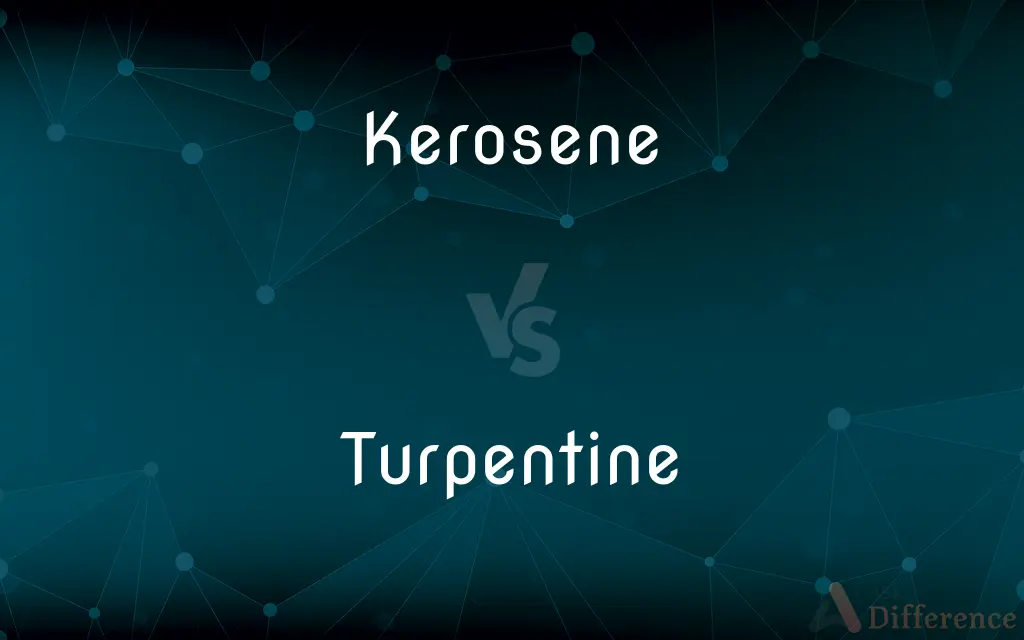Kerosene vs. Turpentine — What's the Difference?
Edited by Tayyaba Rehman — By Fiza Rafique — Updated on September 30, 2023
Kerosene is a flammable hydrocarbon fuel, while turpentine is a volatile solvent from pine tree resin. Both are liquids but serve different primary purposes.

Difference Between Kerosene and Turpentine
Table of Contents
ADVERTISEMENT
Key Differences
Kerosene, a refined petroleum product, is primarily utilized as a fuel in heaters, lamps, and jet engines. Turpentine, derived from the distillation of resin from live pine trees, primarily functions as a solvent for thinning oil-based paints and cleaning brushes.
In its composition, kerosene comprises carbon and hydrogen, giving it its characteristic properties as a fuel. Turpentine, on the other hand, contains organic compounds known as terpenes, making it an effective solvent for specific paint types.
While both kerosene and turpentine are flammable, they differ in their applications. Kerosene's combustion is used to produce heat or light, such as in kerosene lamps. Conversely, turpentine is not typically burned for illumination or heating but is rather a component in various chemical and artistic processes.
Comparison Chart
VOrigin
Refined petroleum product
Distilled pine tree resin
Primary Use
Fuel for heaters, lamps, jet engines
Solvent for paints and varnishes
ADVERTISEMENT
Composition
Carbon and hydrogen
Organic compounds, mainly terpenes
Odor
Distinct fuel or oil-like smell
Pine-like scent
Typical Context
Household heating, aviation fuel
Art studios, paint thinning
Compare with Definitions
Kerosene
Liquid fuel for jet engines.
The plane runs on kerosene fuel.
Turpentine
Natural solvent for organic materials.
Turpentine effectively dissolved the stubborn residue.
Kerosene
Distillate of petroleum used as fuel.
We need more kerosene for the heater.
Turpentine
Liquid for cleaning brushes.
I cleaned my brushes with turpentine after painting.
Kerosene
Alternative to electricity in remote areas.
Many villagers use kerosene lamps for lighting.
Turpentine
Distillate with a pine-like odor.
The studio smelled strongly of turpentine.
Kerosene
Common in household lamps and heaters.
The kerosene stove kept the room warm.
Turpentine
Turpentine (which is also called gum turpentine, spirit of turpentine, oil of turpentine, wood turpentine, terebenthene, terebinthine and (colloquially), turps) is a fluid obtained by the distillation of resin harvested from living trees, mainly pines. Mainly used as a specialized solvent, it is also a source of material for organic syntheses.
Kerosene
A flammable hydrocarbon fuel.
The lantern is powered by kerosene.
Turpentine
A volatile pungent oil distilled from gum turpentine or pine wood, used in mixing paints and varnishes and in liniment.
Kerosene
Kerosene is a combustible hydrocarbon liquid which is derived from petroleum. It is widely used as a fuel in aviation as well as households.
Turpentine
Any of a number of trees which yield turpentine or a similar resin.
Kerosene
A thin oil distilled from petroleum or shale oil, used as a fuel for heating and cooking, in lamps, and as a denaturant for alcohol. Also called coal oil.
Turpentine
Apply turpentine to
Antique turpentining equipment
Kerosene
A thin colorless to straw-colored petroleum-based fuel heavier than gasoline/petrol or naptha but lighter than diesel, used primarily as jet fuel but also for heating and lighting in some remote or impoverished areas.
The kerosene lasted all winter, so the furnace kept us always warm.
Turpentine
A thin volatile terpenoid essential oil, C10H16, obtained by steam distillation or other means from the wood or exudate of certain pine trees and used as a paint thinner, solvent, and medicinally as a liniment. Also called oil of turpentine, spirit of turpentine.
Kerosene
An oil used for illuminating purposes, formerly obtained from the distillation of mineral wax, bituminous shale, etc., and hence called also coal oil. It is now produced in immense quantities, chiefly by the distillation and purification of petroleum. It consists chiefly of several hydrocarbons of the methane series, having from 10 to 16 carbon atoms in each molecule, and having a higher boiling point (175 - 325° C) than gasoline or the petroleum ethers, and a lower boling point than the oils.
Turpentine
The sticky mixture of resin and volatile oil from which turpentine is distilled.
Kerosene
A flammable hydrocarbon oil used as fuel in lamps and heaters
Turpentine
A brownish-yellow resinous liquid obtained from the terebinth.
Turpentine
To apply turpentine to or mix turpentine with.
Turpentine
To extract turpentine from (a tree).
Turpentine
Any oleoresin secreted by the wood or bark of certain trees.
Turpentine
A volatile essential oil now obtained from such oleoresin of from the wood of pine trees by steam distillation; a complex mixture of monoterpenes; now used as a solvent and paint thinner.
Turpentine
(transitive) To drain resin from (a tree) for use in making turpentine.
Turpentine
A semifluid or fluid oleoresin, primarily the exudation of the terebinth, or turpentine, tree (Pistacia Terebinthus), a native of the Mediterranean region. It is also obtained from many coniferous trees, especially species of pine, larch, and fir.
Turpentine
Obtained from conifers (especially pines)
Turpentine
Volatile liquid distilled from turpentine oleoresin; used as paint thinner and solvent and medicinally
Turpentine
Solvent derived from pine resin.
She used turpentine to thin her oil paint.
Turpentine
Component in varnishes and paints.
The varnish contains turpentine for a smoother finish.
Common Curiosities
Is turpentine toxic?
Yes, turpentine is toxic and should be used with caution, avoiding ingestion or prolonged skin contact.
Can turpentine be made at home?
It's not advisable; turpentine production involves distilling pine resin, which requires specific equipment and safety measures.
Can kerosene be used in cars?
Typically, cars run on gasoline, not kerosene. However, some engines can be modified.
Why does kerosene have a distinct smell?
The odor arises from the hydrocarbons and sulfur compounds present in it.
Can kerosene be mixed with diesel?
While possible, it's not always advisable due to varying combustion properties.
How is kerosene produced?
Kerosene is produced through the refining of crude oil.
Is kerosene safe for indoor use?
While kerosene heaters are used indoors, they should be used with proper ventilation to avoid dangerous fumes.
Is turpentine environmentally friendly?
While natural, turpentine can be harmful if released in large quantities into the environment.
What is turpentine primarily used for?
Turpentine is primarily used as a solvent for paints and varnishes.
Is kerosene natural or synthetic?
Kerosene is a refined petroleum product, making it synthetic.
What's the shelf life of kerosene?
Stored properly, kerosene can last for several years but might require filtration before use.
Can turpentine be used as fuel?
While flammable, turpentine is not commonly used as fuel; it's primarily a solvent.
How is turpentine different from white spirit?
While both are solvents, turpentine is natural, derived from pine, whereas white spirit is a petroleum distillate.
Are there alternatives to turpentine in painting?
Yes, mineral spirits or other solvents can sometimes be used in place of turpentine.
Share Your Discovery

Previous Comparison
Erosion vs. Weathering
Next Comparison
Nylon vs. AramidAuthor Spotlight
Written by
Fiza RafiqueFiza Rafique is a skilled content writer at AskDifference.com, where she meticulously refines and enhances written pieces. Drawing from her vast editorial expertise, Fiza ensures clarity, accuracy, and precision in every article. Passionate about language, she continually seeks to elevate the quality of content for readers worldwide.
Edited by
Tayyaba RehmanTayyaba Rehman is a distinguished writer, currently serving as a primary contributor to askdifference.com. As a researcher in semantics and etymology, Tayyaba's passion for the complexity of languages and their distinctions has found a perfect home on the platform. Tayyaba delves into the intricacies of language, distinguishing between commonly confused words and phrases, thereby providing clarity for readers worldwide.
















































